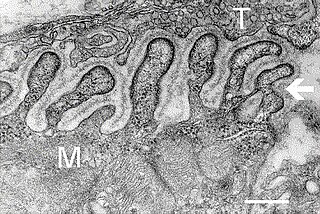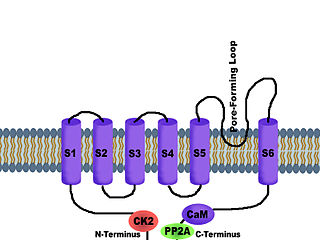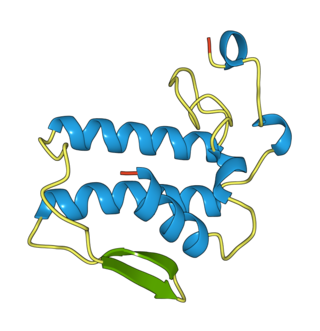Related Research Articles

A neuromuscular junction is a chemical synapse between a motor neuron and a muscle fiber.

The inland taipan, also commonly known as the western taipan, small-scaled snake, or fierce snake, is a species of extremely venomous snake in the family Elapidae. The species is endemic to semiarid regions of central east Australia. Aboriginal Australians living in those regions named the snake dandarabilla. It was formally described by Frederick McCoy in 1879 and then by William John Macleay in 1882, but for the next 90 years, it was a mystery to the scientific community; no further specimens were found, and virtually nothing was added to the knowledge of this species until its rediscovery in 1972.
A latrotoxin is a high-molecular mass neurotoxin found in the venom of spiders of the genus Latrodectus as well as at least one species of another genus in the same family, Steatoda nobilis. Latrotoxins are the main active components of the venom and are responsible for the symptoms of latrodectism.

SK channels are a subfamily of calcium-activated potassium channels. They are so called because of their small single channel conductance in the order of 10 pS. SK channels are a type of ion channel allowing potassium cations to cross the cell membrane and are activated (opened) by an increase in the concentration of intracellular calcium through N-type calcium channels. Their activation limits the firing frequency of action potentials and is important for regulating afterhyperpolarization in the neurons of the central nervous system as well as many other types of electrically excitable cells. This is accomplished through the hyperpolarizing leak of positively charged potassium ions along their concentration gradient into the extracellular space. This hyperpolarization causes the membrane potential to become more negative. SK channels are thought to be involved in synaptic plasticity and therefore play important roles in learning and memory.
Calcicludine (CaC) is a protein toxin from the venom of the green mamba that inhibits high-voltage-activated calcium channels, especially L-type calcium channels.

Calciseptine (CaS) is a natural neurotoxin isolated from the black mamba Dendroaspis p. polylepis venom. This toxin consists of 60 amino acids with four disulfide bonds. Calciseptine specifically blocks L-type calcium channels, but not other voltage-dependent Ca2+ channels such as N-type and T-type channels.
Tityustoxin is a toxin found in the venom of scorpions from the subfamily Tityinae. By binding to voltage-dependent sodium ion channels and potassium channels, they cause sialorrhea, lacrimation and rhinorrhea.
Taipoxin is a potent myo- and neurotoxin that was isolated from the venom of the coastal taipan Oxyuranus scutellatus or also known as the common taipan. Taipoxin like many other pre-synaptic neurotoxins are phospholipase A2 (PLA2) toxins, which inhibit/complete block the release of the motor transmitter acetylcholine and lead to death by paralysis of the respiratory muscles (asphyxia). It is the most lethal neurotoxin isolated from any snake venom to date.

Apamin is an 18 amino acid globular peptide neurotoxin found in apitoxin (bee venom). Dry bee venom consists of 2–3% of apamin. Apamin selectively blocks SK channels, a type of Ca2+-activated K+ channel expressed in the central nervous system. Toxicity is caused by only a few amino acids, in particular cysteine1, lysine4, arginine13, arginine14 and histidine18. These amino acids are involved in the binding of apamin to the Ca2+-activated K+ channel. Due to its specificity for SK channels, apamin is used as a drug in biomedical research to study the electrical properties of SK channels and their role in the afterhyperpolarizations occurring immediately following an action potential.
Tamapin is a toxin from the Indian Red Scorpion, which is a selective and potent blocker of SK2 channels.
Helothermine is a toxin from the venom of the Mexican beaded lizard Heloderma horridum horridum. Helothermine inhibits ryanodine receptors, calcium channels and potassium channels. Helothermine can cause lethargy, partial paralysis of rear limbs and lowering of the body temperature.
Anuroctoxin is a peptide from the venom of the Mexican scorpion Anuroctonus phaiodactylus. This neurotoxin belongs to the alpha family of potassium channel acting peptides. It is a high-affinity blocker of Kv1.3 channels.

Pi3 toxin is a purified peptide derivative of the Pandinus imperator scorpion venom. It is a potent blocker of voltage-gated potassium channel, Kv1.3 and is closely related to another peptide found in the venom, Pi2.
Tamulotoxin is a venomous neurotoxin from the Indian Red Scorpion.
HsTx1 is a toxin from the venom of the scorpion Heterometrus spinifer. HsTx1 is a very potent inhibitor of the rat Kv1.3 voltage-gated potassium channel.
Pi4 is a short toxin from the scorpion Pandinus imperator that blocks specific potassium channels.
SHTX is a toxin derived from the sea anemone Stichodactyla haddoni; there are four different subtypes, SHTX I, II, III and IV. SHTX I, II and III can paralyze crabs by acting on potassium channels, while SHTX IV works on sodium channels, and is lethal to crabs.

Noxiustoxin (NTX) is a toxin from the venom of the Mexican scorpion Centruroides noxius Hoffmann which block voltage-dependent potassium channels and calcium-activated potassium channels.

Notexin is a toxin produced by the tiger snake (Notechis scutatus). It is a myotoxic and presynaptic, neurotoxic phospholipase A2 (PLA2s). These are enzymes that hydrolyze the bond between a fatty acid tail and glycerol in fatty acids on the 2-position.
AsKC11 is a toxin found in the venom of the sea anemone, Anemonia sulcata. This toxin is part of the Kunitz peptide family and has been shown to be an activator of G protein-coupled inwardly-rectifying potassium (GIRK) channels 1/2, involved in the regulation of cellular excitability.
References
- ↑ Brown AM, Yatani A, Lacerda AE, Gurrola GB, Possani LD (1987). "Neurotoxins that act selectively on voltage-dependent cardiac calcium channels". Circ. Res. 61 (4 Pt 2): I6–9. PMID 2443275.
- ↑ Possani LD, Martin BM, Yatani A, Mochca-Morales J, Zamudio FZ, Gurrola GB, Brown AM (1992). "Isolation and physiological characterization of taicatoxin, a complex toxin with specific effects on calcium channels". Toxicon. 30 (11): 1343–64. doi:10.1016/0041-0101(92)90511-3. PMID 1485334.
- ↑ Universal protein resource accession number Q7LZG2 for "Phospholipase A2 taicatoxin" at UniProt.
- ↑ Universal protein resource accession number Q7LZE4 for "Kunitz-type serine protease inhibitor taicotoxin" at UniProt.
- ↑ Doorty KB, Bevan S, Wadsworth JD, Strong PN (1997). "A novel small conductance Ca2+-activated K+ channel blocker from Oxyuranus scutellatus taipan venom. Re-evaluation of taicatoxin as a selective Ca2+ channel probe". J. Biol. Chem. 272 (32): 19925–30. doi: 10.1074/jbc.272.32.19925 . PMID 9242659.
- ↑ Schnee ME, Ricci AJ (2003). "Biophysical and pharmacological characterization of voltage-gated calcium currents in turtle auditory hair cells". J. Physiol. 549 (Pt 3): 697–717. doi:10.1113/jphysiol.2002.037481. PMC 2342991 . PMID 12740421.
- 1 2 Su MC, Lee SY, Tan CT, Su CC, Li SY, Lin RH, Hung CC, Lin MJ (2005). "Taicatoxin inhibits the calcium-dependent slow motility of mammalian outer hair cells" (PDF). Hear. Res. 203 (1–2): 172–9. doi:10.1016/j.heares.2004.12.003. PMID 15855042. S2CID 23849498.
- ↑ Fantini E, Athias P, Tirosh R, Pinson A (1996). "Effect of TaiCatoxin (TCX) on the electrophysiological, mechanical and biochemical characteristics of spontaneously beating ventricular cardiomyocytes". Mol. Cell. Biochem. 160–161: 61–6. doi:10.1007/BF00240032. PMID 8901456. S2CID 20258431.